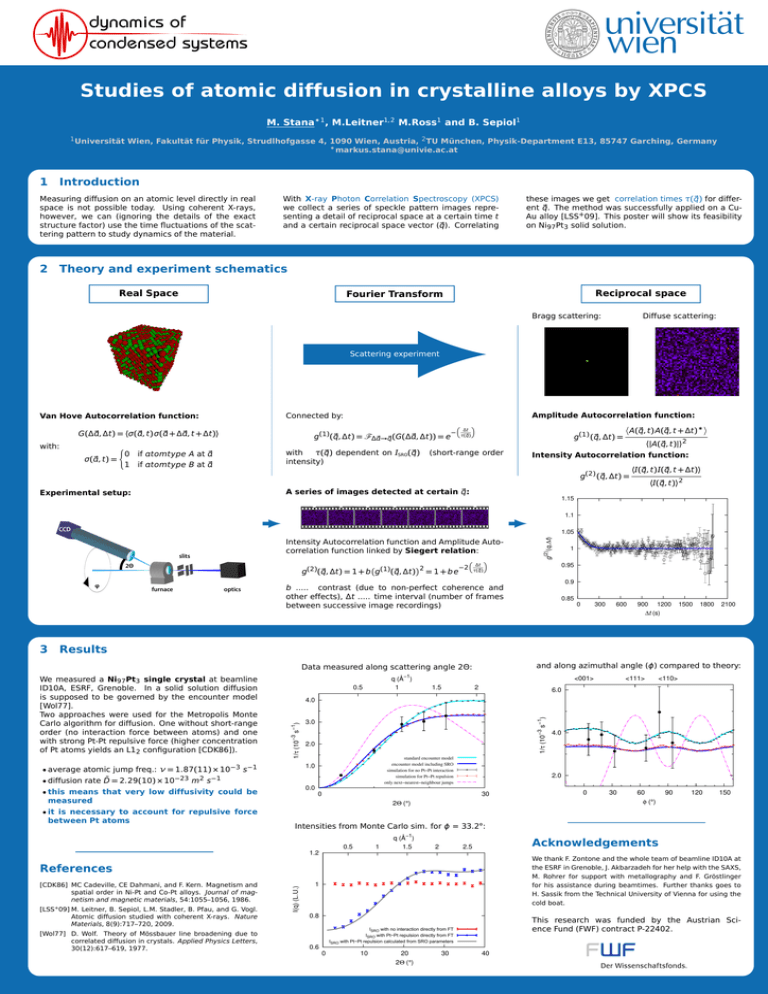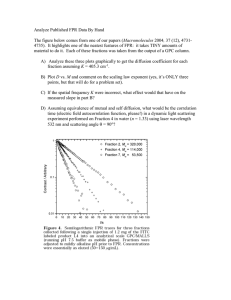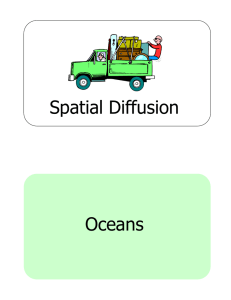Studies of atomic diffusion in crystalline alloys by XPCS
advertisement

Studies of atomic diffusion in crystalline alloys by XPCS M. Stana∗1, M.Leitner1,2 M.Ross1 and B. Sepiol1 1 Universität Wien, Fakultät für Physik, Strudlhofgasse 4, 1090 Wien, Austria, 2 TU München, Physik-Department E13, 85747 Garching, Germany ∗ markus.stana@univie.ac.at 1 Introduction Measuring diffusion on an atomic level directly in real space is not possible today. Using coherent X-rays, however, we can (ignoring the details of the exact structure factor) use the time fluctuations of the scattering pattern to study dynamics of the material. With X-ray Photon Correlation Spectroscopy (XPCS) we collect a series of speckle pattern images representing a detail of reciprocal space at a certain time t ~ ). Correlating and a certain reciprocal space vector (q ~ ) for differthese images we get correlation times τ(q ~ . The method was successfully applied on a Cuent q Au alloy [LSS+ 09]. This poster will show its feasibility on Ni97 Pt3 solid solution. 2 Theory and experiment schematics Real Space Reciprocal space Fourier Transform Bragg scattering: Diffuse scattering: Scattering experiment ~ Δt) = ⟨σ(, ~ t) σ( ~ + Δ, ~ t + Δt)⟩ G(Δ, with: ¨ 0 ~ t) = σ(, 1 Amplitude Autocorrelation function: ∗ ~ , t) A(q ~ , t + Δt) A(q (1) ( ~ g q, Δt) = ~ , t)|⟩2 ⟨|A(q Connected by: Van Hove Autocorrelation function: ~ , Δt) = FΔ→ ~ Δt)) = e g(1) (q ~ q ~ (G(Δ, ~ ) dependent on SRO (q ~) with τ(q intensity) ~ if tomtype A at ~ if tomtype B at − Δt ~) τ(q (short-range order Intensity Autocorrelation function: g ~: A series of images detected at certain q Experimental setup: (2) ( ~ q, Δt) = ~ , t) (q ~ , t + Δt)⟩ ⟨(q ~ , t)⟩2 ⟨(q 1.15 1.1 CCD Intensity Autocorrelation function and Amplitude Autocorrelation function linked by Siegert relation: slits 2Θ φ 2 −2 (2) ~ (1) ~ g (q, Δt) = 1 + b g (q, Δt) = 1 + b e furnace optics Δt ~) τ(q g(2)(q,∆t) 1.05 1 0.95 0.9 b ..... contrast (due to non-perfect coherence and other effects), Δt ..... time interval (number of frames between successive image recordings) 0.85 0 300 600 900 1200 ∆t (s) 1500 1800 2100 3 Results and along azimuthal angle (ϕ) compared to theory: Data measured along scattering angle 2Θ: <001> 1.5 2 1/τ (10−3 s−1) 2.0 0.0 • this means that very low diffusivity could be measured standard encounter model encounter model including SRO simulation for no Pt−Pt interaction simulation for Pt−Pt repulsion only next−nearest−neighbour jumps 30 2Θ (°) 0 30 60 φ (°) 90 120 150 Intensities from Monte Carlo sim. for ϕ = 33.2◦ : 0.5 1 q (Å−1) 1.5 2 Acknowledgements 2.5 We thank F. Zontone and the whole team of beamline ID10A at the ESRF in Grenoble, J. Akbarzadeh for her help with the SAXS, M. Rohrer for support with metallography and F. Gröstlinger for his assistance during beamtimes. Further thanks goes to H. Sassik from the Technical University of Vienna for using the cold boat. I(q) (L.U.) References [Wol77] D. Wolf. Theory of Mössbauer line broadening due to correlated diffusion in crystals. Applied Physics Letters, 30(12):617–619, 1977. 4.0 2.0 0 1.2 [LSS+ 09] M. Leitner, B. Sepiol, L.M. Stadler, B. Pfau, and G. Vogl. Atomic diffusion studied with coherent X-rays. Nature Materials, 8(9):717–720, 2009. <110> 6.0 3.0 1.0 • diffusion rate D̃ = 2.29(10) × 10−23 m2 s−1 [CDK86] MC Cadeville, CE Dahmani, and F. Kern. Magnetism and spatial order in Ni-Pt and Co-Pt alloys. Journal of magnetism and magnetic materials, 54:1055–1056, 1986. <111> 4.0 • average atomic jump freq.: ν = 1.87(11) × 10−3 s−1 • it is necessary to account for repulsive force between Pt atoms q (Å−1) 1 0.5 1/τ (10−3 s−1) We measured a Ni97 Pt3 single crystal at beamline ID10A, ESRF, Grenoble. In a solid solution diffusion is supposed to be governed by the encounter model [Wol77]. Two approaches were used for the Metropolis Monte Carlo algorithm for diffusion. One without short-range order (no interaction force between atoms) and one with strong Pt-Pt repulsive force (higher concentration of Pt atoms yields an L12 configuration [CDK86]). 1 0.8 0.6 This research was funded by the Austrian Science Fund (FWF) contract P-22402. ISRO with no interaction directly from FT ISRO with Pt−Pt repulsion directly from FT ISRO with Pt−Pt repulsion calculated from SRO parameters 0 10 20 2Θ (°) 30 40


